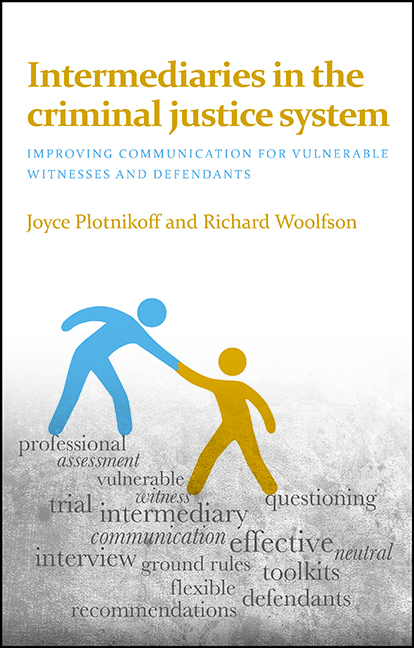 Intermediaries in the Criminal Justice System
Intermediaries in the Criminal Justice System Book contents
- Frontmatter
- Contents
- About the authors
- The Nuffield Foundation
- Acknowledgements
- Foreword
- one Introduction: a fresh pair of eyes
- two The intermediary scheme in England and Wales
- three Behind the scenes: planning to assess the witness
- four Assessment methods and involvement of the interviewer
- five Communication aids and stress reduction strategies
- six Contributing to the effectiveness of the police interview
- seven Negotiating professional space at the ground rules hearing
- eight Making the ground rules hearing effective
- nine ‘Every reasonable step’: preparation for giving evidence
- ten Cross-examination: research, case law, training and regulation
- eleven Cross-examination: intervention at trial
- twelve Cross-examination: challenges at the cutting edge
- thirteen The uneasy position of vulnerable defendants
- fourteen A new profession
- fifteen Conclusion
- References
- Index
- Table of cases
- Legislation
- Rules
- Practice directions
seven - Negotiating professional space at the ground rules hearing
Published online by Cambridge University Press: 08 March 2022
- Frontmatter
- Contents
- About the authors
- The Nuffield Foundation
- Acknowledgements
- Foreword
- one Introduction: a fresh pair of eyes
- two The intermediary scheme in England and Wales
- three Behind the scenes: planning to assess the witness
- four Assessment methods and involvement of the interviewer
- five Communication aids and stress reduction strategies
- six Contributing to the effectiveness of the police interview
- seven Negotiating professional space at the ground rules hearing
- eight Making the ground rules hearing effective
- nine ‘Every reasonable step’: preparation for giving evidence
- ten Cross-examination: research, case law, training and regulation
- eleven Cross-examination: intervention at trial
- twelve Cross-examination: challenges at the cutting edge
- thirteen The uneasy position of vulnerable defendants
- fourteen A new profession
- fifteen Conclusion
- References
- Index
- Table of cases
- Legislation
- Rules
- Practice directions
Summary
Courtrooms are traditional, deferential places in which everyone knows their place in the hierarchy and jealously guards their professional space. The intrusion of an outsider can be regarded with suspicion. We saw an example of this during our evaluation of real-time computer-aided transcription (Plotnikoff and Woolfson, 1993). As the judge, lawyers and witnesses spoke at trial, a highly trained stenographer (whose skills cost more than her equipment) created a transcript seen immediately on the computer screens of the judge and lawyers, allowing them to annotate text as it appeared. At the start of the evaluation, the stenographer was seated below the judge’s bench, close to the witness box – the ideal position to hear what was being said. Nevertheless, a few days into the experiment, the stenographer was shifted to a seat further away where it was harder for her to hear accurately. She had been moved because she had taken the position normally occupied by the clerk when swearing witnesses and passing papers to the judge.
The ground rules hearing, a new type of case management hearing, is where intermediaries carve out their own space in professional, not merely physical, terms. For the first time, someone other than the judge or opposing counsel may interrupt questioning at trial (Henderson, 2015c, forthcoming). Those with a traditional view of the courtroom hierarchy may argue that intermediaries are unnecessary, that they are likely to interfere with witness cross-examination and possibly even compromise the judge’s control of proceedings. Intermediaries try to allay such concerns at the ground rules hearing. It is designed to facilitate ‘a more intense consideration of issues’ by bringing together intermediaries, lawyers and judiciary to resolve how best to communicate with vulnerable witnesses at trial (Ministry of Justice, 2014a, p 4). This chapter explores how ground rules hearings came about and why, 10 years on, intermediaries sometimes still find themselves negotiating their professional space on a case by case basis.
The case management background
Government objectives for ‘active and effective case management’ include the early identification of trial issues, ‘achieving certainty as to what must be done, by whom, and when’; the early setting of a timetable for the progress of the case; monitoring compliance with judicial directions; discouraging delay; and encouraging the cooperation of participants in moving the case forward. (Ministry of Justice, 2014a, p 10)
- Type
- Chapter
- Information
- Intermediaries in the Criminal Justice SystemImproving Communication for Vulnerable Witnesses and Defendants, pp. 97 - 108Publisher: Bristol University PressPrint publication year: 2015


